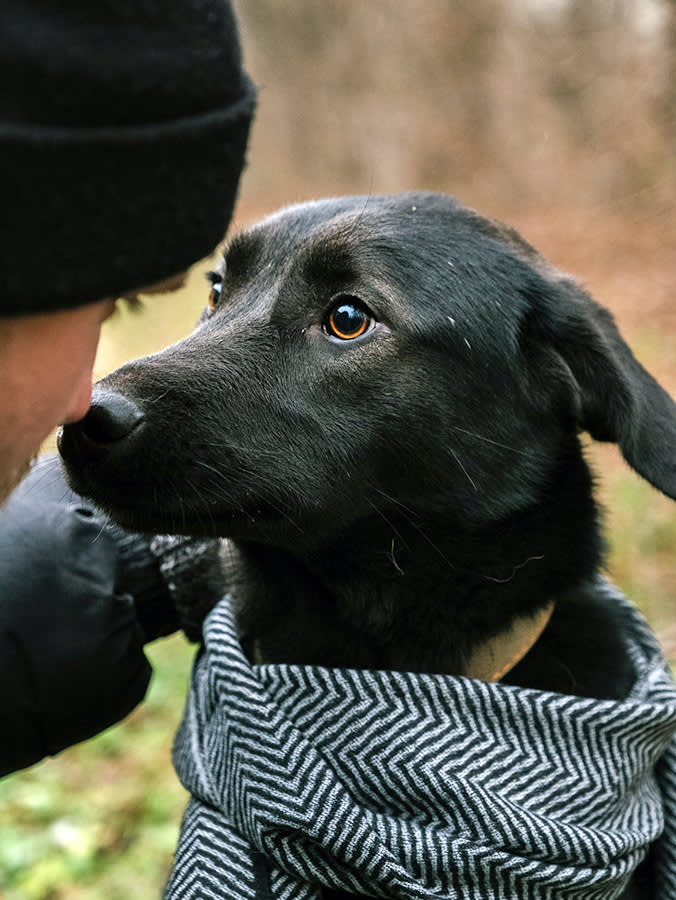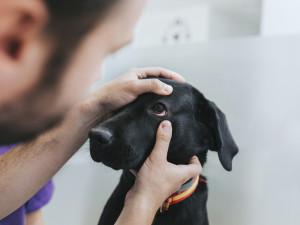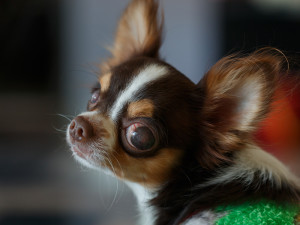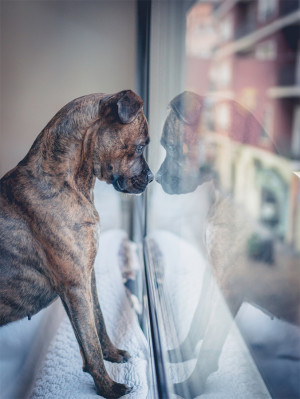Conjunctivitis in Dogs: How to Identify and Treat Pink Eye at Home
Don’t worry—with a vet’s help, things will be OK.

Share Article
In This Article:
Types of Conjunctivitis Common Causes Symptoms of Pink Eye How to Treat Pink Eye When to Consult a Vet
If your dog’s soulful eyes are suddenly squinty, red, or goopy, you may be dealing with pink eye. Pink eye is a common term for conjunctivitis, or inflammation of the outer membrane of the eye. Conjunctivitis may include a variety of symptoms, including redness of the eye, yellow, or greenish eye discharge, frequent rubbing, squinting, and/or increased tear production.
Dogs may also experience crusting around the eye or noticeable inflammation that can affect one or both eyes. Eye conditions always warrant a trip to the vet; the eyes are very delicate and can sustain long-term damage if they are not treated properly and swiftly. Read on to learn all you ever wanted to know about conjunctivitis in dogs.
Types of conjunctivitis (pink eye)
Conjunctivitis describes the signs of inflammation of the conjunctiva, or the clear outer membrane that covers the surface of the eyeball and inner lining of the eyelids. This type of inflammation can have many different causes. There are also other eye conditions that have similar signs but very different causes. It is important to have your vet diagnose conjunctivitis to be sure that is the problem and to provide safe and effective treatment.

How to identify different types of eye issues
Many times, you will not be able to distinguish different eye issues solely by looking at your dog’s eye. In part this may be because your dog is uncomfortable and won’t allow you to get a close look. Additionally, specialized equipment and diagnostic tools are needed to diagnose many types of eye conditions. Careful observations of the signs your pup is experiencing can help you home in on the type of problem, including:
Is the problem affecting one eye or two eyes?: Many conditions will affect both eyes at the same time, while others only affect one eye. This can help narrow down the list of possibilities.
Look at the skin surrounding the eyes: Some conditions will affect the fur and/or skin around the eyes, known as the periocular area, in addition to the eyes themselves.
Examine the eyelids: Note any swelling, discoloration, or lumps on the eyelids.
Note any discharge from the eyes: Mucus, pus, blood, or excessive tears are all forms of eye discharge that accompany different conditions and can distinguish them from each other.
Look at the surface of the eyeball: Does the eyeball itself look shiny and smooth, or are there any dents or abnormalities in the surface? Note any changes to the eyeball, including swelling, cloudiness, or any defects on the surface.
Check for any other signs of illness: Some conditions that cause body-wide illness may also cause changes to the eyes. If your dog has eye issues along with other physical problems, like a fever, change in appetite, lethargy, vomiting, or breathing difficulty, these could be signs of a broader problem and require immediate veterinary attention.
Common causes of canine conjunctivitis
Allergic reactions
Dogs with allergies may develop allergic conjunctivitis. You may suspect this if your dog has other signs of allergies and/or the signs seem to come and go with the seasons or other specific triggers. This can also happen suddenly with an allergic reaction to an insect bite or medication. Allergic conjunctivitis also tends to affect both eyes at the same time, may be more itchy, and can result in hair loss around the eyes.
Congenital abnormalities
Sometimes, dogs are born with variations in the shape of their eye or eyelid that cause inflammation, which may lead to conjunctivitis. A common example of this is entropion, where the eyelids are rolled inwards, causing the eyelashes to rub on the surface of the eye.
Eye trauma
Scratches and wounds to the eye are extremely painful so most of the time, if your dog has an eye injury they will have their eye shut tight and will not want you to open it. This is a clear sign of pain and means they need to see a vet right away. Eye injuries usually only affect one eye.
Environmental irritants
The eyes are very delicate and any materials that get into the eye can cause inflammation. This can include dust, pollen, and other plant material, including foxtail s, which can also cause injuries to the eyes. One or both eyes may be affected depending on the irritant and how they were exposed.
Bacterial, viral or fungal Infections
Infections are not a very common primary cause for conjunctivitis in dogs, but they are in cats. In dogs, they can be a secondary problem that sets in due to another source of irritation. There is no way to know whether an infection is caused by a bacteria, virus, or fungus based on the general appearance of the eye, but most eye infections are bacterial in dogs. A swab of the eye can be cultured to determine the type of infection but in most cases this is not necessary.
Additional risk factors
Some dogs may have predisposing factors that put them at risk for conjunctivitis or other eye conditions with a similar appearance. This includes:
Underlying health conditions: Dogs with chronic conditions, like allergies, autoimmune diseases, and certain systemic infections may be at risk for certain eye problems.
Breed predispositions: Dogs with eyes that seem to bulge out — like Pugs, French Bulldogs, Shih Tzus — Boston Terriers, and Chihuahuas can be more at risk for eye problems in general. This is because more of their eyeball is exposed, leaving it unprotected.
Age-related vulnerabilities: Certain eye changes may happen with age including cataracts (clouding of the lens), glaucoma (increased pressure within the eye) or dry eye (reduced tear production). These kinds of age-related changes can also lead to secondary inflammation or infections of the eyes.
How to identify canine conjunctivitis
You need a veterinarian with specialized equipment to make an official diagnosis of conjunctivitis. There are many other eye problems that look similar in their general appearance but have very different causes. That said, there are some valuable observations you can make at home to help narrow down the possibilities:
Common visual symptoms of pink eye
Depending on underlying cause, you may see all or just some of the following:
Eye redness: When a dog has pink eye, the eyeball and eyelids may look red and inflamed.
Discharge characteristics: Dogs with pink eye often have eye discharge that may look like mucus or pus. Sometimes they may also have excessive tearing.
Swelling or inflammation: Inflammation on the surface of the eye, the conjunctiva, is called conjunctivitis, or pink eye. This usually has a red appearance. Some causes of pink eye may cause swelling of the eye, but this is less common.
Behavioral changes: Dogs with eye discomfort often hold their eye tightly closed. They may rub their face against furniture, the floor, and/or people trying to find relief or paw at the affected eye. Some dogs may also display other signs of pain as well.
Variations of pink eye
There are so many different causes for pink eye so one case can vary greatly from the next. Some general characteristics to note include:
Acute vs. chronic conjunctivitis: Acute conjunctivitis occurs suddenly and resolves quickly, usually within a matter of days. Chronic conjunctivitis may last weeks or months, and in some cases it may be recurrent, meaning that it seems to improve but then comes back shortly thereafter. Chronic or recurrent cases are red flags that there is an underlying condition that has not yet been treated. It is important to follow up with your vet or consult a veterinary ophthalmologist in these cases.
Unilateral vs. bilateral infection: This describes whether only one eye is affected (unilateral) or both eyes (bilateral). Many conditions tend to affect both eyes at the same time, while others, like traumatic injuries, typically only affect one eye.
Scale of severity: Conjunctivitis may be described as mild, moderate, or severe. This may be based on specific changes to the eye that a veterinarian observes, as well as a dog’s degree of discomfort. Any dog experiencing severe signs should be closely monitored by a vet to avoid more serious complications.
Home treatment of conjunctivitis
It’s very important to note that you cannot cure conjunctivitis at home without medication or treatment prescribed by a vet. There are helpful steps you can take to keep your dog comfortable, but none of these will cure the underlying cause.
The eyes are very delicate, and untreated conjunctivitis is not only very painful for dogs, but it can also lead to serious complications, which can impact your dog’s vision and/or require removal of the affected eye. Be sure to see a vet right away to start treatment and consider using the following supportive care measures at home:
How to support your dog’s pink eye treatment at home
Gentle cleaning: You can use a moist washcloth or paper towel to gently clean around your dog's eye to remove any crusting or discharge. Never put these materials into the eye; they could cause injury. If your dog is in a lot of pain, they may not want to be touched ,so go slow and respect their body language.
Cold compress methods: A cold compress can feel soothing and reduce inflammation. You can make a cold compress with a moist washcloth or paper towel that you refrigerate or freeze for a few minutes to cool it down. If your dog will tolerate it, you can hold the compress in place over their closed eye for 10 to 15 minutes at least two or three times a day.
Pet-friendly over the counter conjunctivitis supplements
Eye drops: You can purchase a product that can be used to gently flush out mucus or other discharge from the eye and keep the eye moist. Never touch the tip of the product directly to the eye, as this can cause injuries. Ask your vet before using this product because may interfere with medicated drops they prescribe.
Supplemental care products: You may need to prevent your dog from further injuring their eye by rubbing or pawing at it. The most effective way to do this is with a cone they can wear when unsupervised.
Immune system support: Depending on the cause of your dog’s conjunctivitis, they may benefit from additional steps to boost their overall health and immunity.
Those additional steps include:Proper nutrition: All dogs should be eating a complete-and-balanced diet that provides all of the nutrients they need. Commercial dog food diets are formulated to meet daily nutritional needs if they include an AAFCO statement of nutritional adequacyopens in new tab.
Stress reduction: Stress can affect immune function and healing. Be sure to give your dog a quiet, calm place to recover and to address any underlying fears or anxieties your pup may struggle with.
Health maintenance: Be sure to keep up with routine healthcare for your dog including vaccines, deworming, and yearly physical exams in order to prevent many forms of illness and catch other changes before they become serious.
How to prevent recurrence
Complete all treatments as directed by your vet: Be sure to finish all medications and follow up for any additional treatments your dog needs. Recurrence within a short period of time is often a sign that the underlying problem was not resolved and may require additional testing or treatment to get to the bottom of it.
Maintain eye hygiene: If you have a dog that has other eye problems be sure to keep up with their routine care, medications, and treatments. Do your best to keep the eyes clear of discharge, crusting, and any debris. If you live in an area where grass awns are a problem, consider protective gear for hikes.
Regular grooming: Dogs who have long fur around their eyes and face need regular grooming to trim it. When this fur combines with eye gunk it can create painful matted fur that can exacerbate eye problems. Be sure to keep this fur trimmed short and clean their face daily.
Routine veterinary care: Keep up with routine check-ups for your dog, especially if they have underlying eye problems that require more frequent tune-ups. Your vet may be able to catch certain eye changes before they cause a problem for your pup.
When to seek professional help
It is worth repeating that all eye problems warrant a trip to the vet as soon as possible. Unlike some other health problems, these are not situations to wait and see and hope it gets better on its own. More often than not, they can quickly get worse, not better. Additional reasons to see a vet or schedule a follow-up include:
Consult a vet if your pup for all eye problems and if they have
Persistent symptoms: If you are noticing that your pup is not improving within the expected time frame provided by your vet, be sure to schedule a follow up.
Medical complications: If you are noticing additional signs or problems that were not there at the initial vet visit, be sure to contact your vet. This may require additional treatment or medications.
Secondary infections: If you are concerned that your dog’s eye looks infected when it didn’t before, including lots of green or pus-colored discharge, be sure to see a vet right away.
Bottom line
Conjunctivitis is a descriptive term for many different conditions that cause inflammation of the conjunctiva, or the outer membrane of the eye
Signs of conjunctivitis include redness, swelling, discharge, and/or pain, which can resemble many other eye conditions.
It is very important to seek veterinary treatment for conjunctivitis and all eye conditions because the eyes are very delicate and problems can quickly worsen, leading to serious complications
References
Delgado, Esmeralda, et al. “Diagnostic approach and grading scheme for canine allergic conjunctivitisopens in new tab.” BMC Veterinary Research, vol. 19, no. 35, 3 February 2023,.
Heinrich, Christine. “Assessing Canine Conjunctivitisopens in new tab.” Vet Times, 14 September 2015.
Ledbetter, Eric. “Diagnosing, Treating, and Managing Causes of Conjunctivitis in Dogs and Catsopens in new tab.” Today’s Veterinary Practice, May/June 2021.

Dr. Amy Fox, DVM
Amy Fox, DVM is a small animal veterinarian in New York City with over thirteen years of experience in a mixture of general practice, emergency medicine, and shelter medicine. A lifelong animal lover, Dr. Fox studied biology in college and then worked as a veterinary nurse before pursuing veterinary school at Cornell University. Her expertise includes surgery, dentistry, and management of chronic conditions, and she is interested in toxicology, pain management, nutrition, care of senior pets, and educational outreach. Dr. Fox also enjoys writing about veterinary medicine and teaching, and her work has previously appeared in Spruce Pets. In her free time, she loves to cook, garden, go for long runs, and hang out with her goofy mixed-breed dog May, who provides never ending comic relief!
Related articles
Cherry Eye in Dogs: Why Is Your Dog’s Eye So Red?
That would be a cherry eye, and you’ll want to see your vet.
![close up of Chihuahua dog's eye with cataracts]()
Common Eye Problems in Dogs and How to Treat Them
Your dog sees you as their best friend, so keep those eyes healthy.
![Jack Russel Terrier mixed breed dog laying on his back on a white and gray rug getting his belly rubbed by his owner]()
How to Do a DIY Dog Checkup in 7 Steps
You can do a DIY exam on your dog from your couch.
Cloudy Eyes in Dogs: Causes, Risks, and How to Manage Vision Changes
There are a few possible reasons for your pup’s murky stare.
![Dog Looking Out The Window.]()
Dog Vision: What Do Dogs See?
Those soulful eyes mean everything to you—learn all about them.
Can Dogs See in the Dark? Does My Dog Have Night Vision?
Hopefully, they at least fare better than we do when the lights go out.







